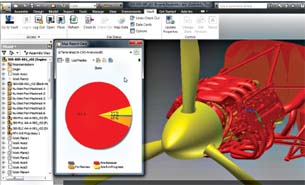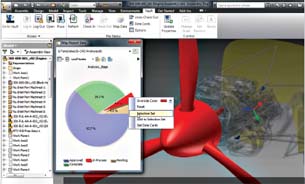Take 5 Steps to Protect Your ‘Legacy’
Autodesk Vault can help organize and manage all of your historical engineering data so that it's there when you need it.
Latest News
January 1, 2011
By Darren Hartenstine
 Autodesk Vault’s visual data-management environment, with red highlights to display subassembly components in pre-release phase. Image courtesy of Autodesk |
Old data: Everyone who uses a computer has it. In my consulting visits with manufacturers, I have seen many attempts at securing and managing their legacy of information, which typically consists of paper drawings, electronic drawings, 3D models, MS Word and Excel documents, and more.
As a consultant for an Autodesk reseller, we implement the Autodesk Vault products. When we implement our data management solution, we recommend importing all our clients’ engineering data—some of which was created decades ago. To successfully import this data, it must go though several steps to guarantee the information is up-to-date and accessible:
1. Evaluate the Data
Understanding what, where and how much data exists will provide the current state of the information and help plan for the next steps. There are many tools available to scan and document legacy information before it can be imported into the Autodesk Vault.
We use a tool called Autodesk Autoloader during the various phases of an implementation. In the initial phase, it provides us with a list of the CAD data and any issues that may exist.
To set it up properly, we add the various root folders that contain the customer’s engineering data. Autoloader will scan each of the folders, determine whether the data is older than a particular product release, and validate the location of the external references (XREFs) for AutoCAD files and the parent-child relationships for Autodesk Inventor files. Any issues will be documented and outputted into various file formats for review.
These file relationship issues can be caused by users renaming, deleting or moving files without updating the parent file with the changes. The files that are marked as problems must be fixed before the data is imported into Autodesk Vault. This is my primary rule for implementing Autodesk Vault—or the results will be detrimental to the success of the implementation. As the old saying goes, “garbage in, garbage out.”
 Project data is housed in Autodesk Vault, but can be displayed inside an Autodesk Inventor assembly file with in-process components isolated in red. Image courtesy of Autodesk |
Autoloader will also search the selected folders for duplicate files. Although the output of duplicate files is important, they can still be imported into Autodesk Vault. We typically recommend importing the duplicate files into Autodesk Vault and using the various tools within Vault to rectify the duplicate file issues.
2. Clean up the Data
From the previous step, we have a list of “bad” files that must be repaired before they can be imported successfully to Autodesk Vault. The log file from Autoloader will list the location of the parent files, as well as each of the issues with the children files.
Repairing the files in this stage is typically the responsibility of the customer, because of the liability of the process. The customer knows its data and can make the determination of which files are used to repair the issues.
3. Migrate the Data
Depending on the amount of CAD data and the various CAD applications used, this step could potentially take some time to complete. We typically work with AutoCAD and Autodesk Inventor data and use two separate programs to perform the migration.
For AutoCAD data, we will run an automated tool that will recover corrupted files, purge unused entities, migrate it to the latest version and configure page setups for each file.
Usually with Inventor data, we only need to migrate to the latest version using Autodesk Task Scheduler, which is available with any version of Autodesk Inventor.
Each of these tools can be distributed among several computers to process the data in parallel. This provides faster processing of all of the AutoCAD and Inventor data.
What to Do with Paper Drawings Additional information like Description, Part Number, Material, etc., can be added once the data has been imported to Autodesk Vault. |
4. Import the Data
Using Autodesk Autoloader, the engineering data is scanned a final time. This will tell us whether all of the data has been repaired or migrated to the latest release.
When all is successful, the importation process can begin. This process is automated and can take some time, depending on the number of files. Autoloader can be run on several computers during this phase to optimize performance.
5. Make the Data ‘Intelligent’
Once the files are imported into Autodesk Vault, additional intelligence can be added. Some of this may have been automatic by using the block attribute names or iProperties that exist within AutoCAD and Inventor files and indexing the values. Examples include the description, part number, created by, etc., which are usually located in the title block of the drawing. With non-Autodesk files, the Vault can index standard file properties like Title, Subject, Keywords, Category, Comments, Author, etc.
If these properties contain data, Autodesk Vault will automatically populate the equivalent property in the database for Vault. This makes it easier to search and organize data within the Vault. If the properties are blank, the Vault will allow for easy editing and the data can be synchronized back to the original file.
With all implementations, the process of analyzing, preparing, importing and maintaining the legacy data is similar. What tasks are performed and what data is imported may differ based on the needs and requirements of a client’s design processes.
The bottom line, however, is that there are many benefits that result from this effort—including easy access, searching, editing and design reuse.
More Info:
Autodesk
MasterGraphics
Darren Hartenstine has been with MasterGraphics since 2005, specializing in data management solutions for the manufacturing industry. He consults with manufacturing companies to implement data management and enterprise solutions. Prior to joining MasterGraphics, he worked as a CAD/Unix administrator, an engineering consultant and a mechanical engineer. Contact him via [email protected].
Subscribe to our FREE magazine, FREE email newsletters or both!
Latest News
About the Author
DE’s editors contribute news and new product announcements to Digital Engineering.
Press releases may be sent to them via [email protected].






